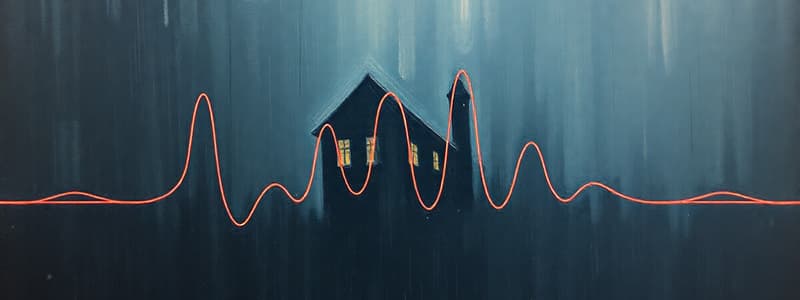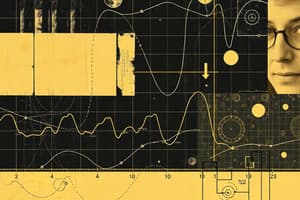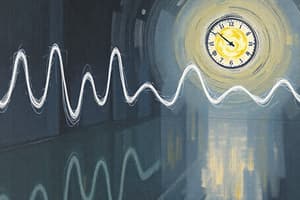Podcast
Questions and Answers
Given that figure $A'B'C'D'$ is a dilation of figure $ABCD$, determine the scale factor.
Given that figure $A'B'C'D'$ is a dilation of figure $ABCD$, determine the scale factor.
- 0.5
- 1
- 2 (correct)
- 4
Triangle $ABC$ is congruent to triangle $DEF$. Identify the transformation that maps triangle $ABC$ to triangle $DEF$.
Triangle $ABC$ is congruent to triangle $DEF$. Identify the transformation that maps triangle $ABC$ to triangle $DEF$.
- Reflection across the y-axis (correct)
- Rotation 90° counterclockwise about the origin
- Reflection across the line $x = \frac{1}{2}$
- Rotation 270° counterclockwise about the origin
Triangles $DEF$ and $XYZ$ are similar. Which proportion could be used to find the length of side $XY$?
Triangles $DEF$ and $XYZ$ are similar. Which proportion could be used to find the length of side $XY$?
- $\frac{EF}{YZ} = \frac{DE}{XY}$
- $\frac{EF}{YZ} = \frac{XY}{DE}$
- $\frac{4.7}{9.4} = \frac{6.8}{XY}$
- $\frac{9.4}{4.7} = \frac{XY}{6.8}$ (correct)
A tree in Janessa's backyard is 15.5 feet tall and casts a shadow that is 24 feet long. At the same time, Janessa casts a shadow of 9 feet. Determine Janessa's height.
A tree in Janessa's backyard is 15.5 feet tall and casts a shadow that is 24 feet long. At the same time, Janessa casts a shadow of 9 feet. Determine Janessa's height.
Triangle $ABC$ has coordinates $A(0, 0)$, $B(2, 5)$, and $C(4, 0)$. Triangle $A'B'C'$ is the image of triangle $ABC$ after a dilation with center at the origin and a scale factor of 3. What are the coordinates of point $B'$?
Triangle $ABC$ has coordinates $A(0, 0)$, $B(2, 5)$, and $C(4, 0)$. Triangle $A'B'C'$ is the image of triangle $ABC$ after a dilation with center at the origin and a scale factor of 3. What are the coordinates of point $B'$?
Which of the following figures represents a translation of Figure 1?
Which of the following figures represents a translation of Figure 1?
The vertices of figure $KLMN$ are $K(-2, -1)$, $L(-2, -3)$, $M(-5, -3)$, and $N(-5, -1)$. If figure $KLMN$ is reflected across the line $x = 2$, what are the coordinates of vertex $N'$?
The vertices of figure $KLMN$ are $K(-2, -1)$, $L(-2, -3)$, $M(-5, -3)$, and $N(-5, -1)$. If figure $KLMN$ is reflected across the line $x = 2$, what are the coordinates of vertex $N'$?
What are the coordinates of the vertices of the resulting image $A'B'C'D'E'$ after rotating the figure $ABCDE$ 90° counterclockwise about the origin?
What are the coordinates of the vertices of the resulting image $A'B'C'D'E'$ after rotating the figure $ABCDE$ 90° counterclockwise about the origin?
A triangle $ABC$ is reflected across the line $x = -1$. Which coordinate transformation accurately represents this reflection?
A triangle $ABC$ is reflected across the line $x = -1$. Which coordinate transformation accurately represents this reflection?
Consider the figures on the coordinate plane. Which two figures are congruent?
Consider the figures on the coordinate plane. Which two figures are congruent?
Consider the figures on the coordinate plane. Describe the transformation that maps the congruent figures.
Consider the figures on the coordinate plane. Describe the transformation that maps the congruent figures.
If a point $(x, y)$ is rotated $180^\circ$ counterclockwise about the origin, what are its new coordinates?
If a point $(x, y)$ is rotated $180^\circ$ counterclockwise about the origin, what are its new coordinates?
Triangle $PQR$ has vertices $P(1, 2)$, $Q(3, 4)$, and $R(5, 2)$. If the triangle is translated by the rule $(x, y) \rightarrow (x - 2, y + 1)$, what are the coordinates of vertex $Q'$?
Triangle $PQR$ has vertices $P(1, 2)$, $Q(3, 4)$, and $R(5, 2)$. If the triangle is translated by the rule $(x, y) \rightarrow (x - 2, y + 1)$, what are the coordinates of vertex $Q'$?
Which transformation preserves both the size and shape of a figure but may change its orientation?
Which transformation preserves both the size and shape of a figure but may change its orientation?
If a figure is dilated by a scale factor of 0.5, which of the following statements is true about the image?
If a figure is dilated by a scale factor of 0.5, which of the following statements is true about the image?
Point $A(4, -3)$ is rotated $90^\circ$ clockwise about the origin. What are the coordinates of the image $A'$?
Point $A(4, -3)$ is rotated $90^\circ$ clockwise about the origin. What are the coordinates of the image $A'$?
Which of the following transformations does not guarantee that the image is congruent to the original figure?
Which of the following transformations does not guarantee that the image is congruent to the original figure?
A rectangle has vertices at $(1, 1)$, $(1, 4)$, $(5, 4)$, and $(5, 1)$. If the rectangle is reflected over the x-axis, what are the new coordinates of the vertex that was originally at $(1, 4)$?
A rectangle has vertices at $(1, 1)$, $(1, 4)$, $(5, 4)$, and $(5, 1)$. If the rectangle is reflected over the x-axis, what are the new coordinates of the vertex that was originally at $(1, 4)$?
A transformation is defined by the rule $(x, y) \rightarrow (2x, y + 3)$. If the point $(3, 1)$ is transformed, what are the coordinates of its image?
A transformation is defined by the rule $(x, y) \rightarrow (2x, y + 3)$. If the point $(3, 1)$ is transformed, what are the coordinates of its image?
Consider a point rotated $270^\circ$ counterclockwise about the origin. Which single rotation is equivalent to this transformation?
Consider a point rotated $270^\circ$ counterclockwise about the origin. Which single rotation is equivalent to this transformation?
A triangle is reflected across the y-axis. How does this transformation affect the coordinates of the triangle's vertices?
A triangle is reflected across the y-axis. How does this transformation affect the coordinates of the triangle's vertices?
A square with vertices $A(0, 0)$, $B(2, 0)$, $C(2, 2)$, and $D(0, 2)$ undergoes a dilation centered at the origin with a scale factor of 2, followed by a translation of 1 unit to the right and 3 units up. What are the final coordinates of vertex $C'$?
A square with vertices $A(0, 0)$, $B(2, 0)$, $C(2, 2)$, and $D(0, 2)$ undergoes a dilation centered at the origin with a scale factor of 2, followed by a translation of 1 unit to the right and 3 units up. What are the final coordinates of vertex $C'$?
Before a figure is dilated, a line segment on the pre-image has a length of 5 units. After the dilation, how long is this line segment?
Before a figure is dilated, a line segment on the pre-image has a length of 5 units. After the dilation, how long is this line segment?
Which proportion is set up correctly to determine the unknown length $x$ between two similar objects?
Which proportion is set up correctly to determine the unknown length $x$ between two similar objects?
Flashcards
What is a scale factor?
What is a scale factor?
The ratio of the lengths of corresponding sides in similar figures.
What is congruence?
What is congruence?
A transformation that maps a figure onto itself; the figure looks the same after the transformation.
What is rotation?
What is rotation?
A transformation in which a figure is turned about a fixed point.
What is a proportion?
What is a proportion?
Signup and view all the flashcards
What is dilation?
What is dilation?
Signup and view all the flashcards
What is reflection?
What is reflection?
Signup and view all the flashcards
What is Translation?
What is Translation?
Signup and view all the flashcards
What is similarity?
What is similarity?
Signup and view all the flashcards
Study Notes
- The frequency response indicates how a system alters the magnitude and phase of an input signal across various frequencies.
- It is mathematically expressed as H(jw) = Y(jw) / X(jw), where X(jw) is the input and Y(jw) is the output signal.
First Order System Example
- A transfer function is given as H(s) = 1 / (s + 1).
- By replacing s with jw, the frequency response becomes H(jw) = 1 / (jw + 1).
- The magnitude is calculated as |H(jw)| = 1 / √(w^2 + 1).
- The phase is given by φ(w) = -arctan(w).
Bode Plot
- The Bode plot visually represents a system's frequency response.
- It includes a magnitude plot (dB vs. log frequency) and a phase plot (degrees vs. log frequency).
Creating a Bode Plot
- Convert H(jw) into the time constant form: H(jw) = 1 / (1 + jw).
- Magnitude Plot:
- For w > 1, 20log|H(jw)| ≈ 20log(1/w) = -20log(w).
- The plot is a straight line with a -20 dB/decade slope.
- Phase Plot:
- For w > 1, φ(w) = -arctan(∞) = -90°.
- For w = 1, φ(w) = -arctan(1) = -45°.
Second Order System
- A general transfer function is H(s) = wn^2 / (s^2 + 2ζwn s + wn^2).
- Substituting s with jw gives H(jw) = wn^2 / ((jw)^2 + 2ζwn (jw) + wn^2).
- Which simplifies to H(jw) = wn^2 / (-w^2 + 2jζwn w + wn^2).
- The magnitude is |H(jw)| = wn^2 / √((wn^2 - w^2)^2 + (2ζwn w)^2).
- The phase is φ(w) = -arctan((2ζwn w) / (wn^2 - w^2)).
- A simplified magnitude is |H(jw)| = 1 / √((1 - (w/wn)^2)^2 + (2ζ (w/wn))^2).
Second Order System Example
- Given a transfer function H(s) = 1 / (s^2 + 0.2s + 1), it means that wn = 1 and ζ = 0.1.
- Magnitude values at specific frequencies:
- At w = 0.1, |H(jw)| = 0.99.
- At w = 0.5, |H(jw)| = 1.14.
- At w = 1, |H(jw)| = 5.
- At w = 2, |H(jw)| = 0.24.
- At w = 5, |H(jw)| = 0.04.
Studying That Suits You
Use AI to generate personalized quizzes and flashcards to suit your learning preferences.




